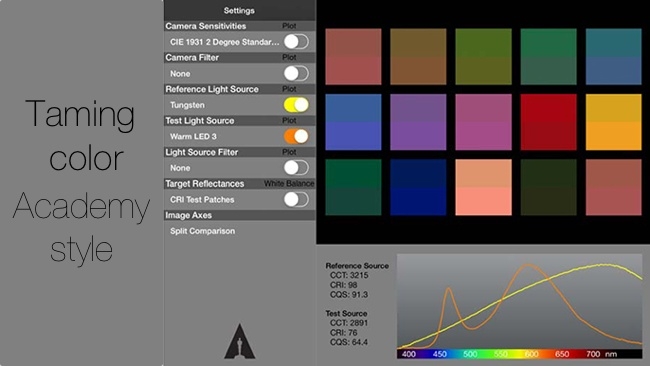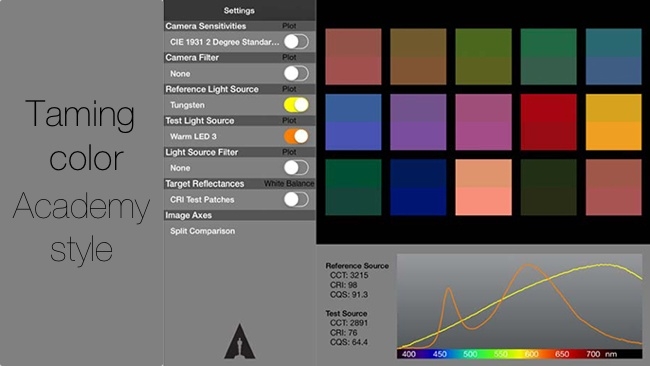

First released at NAB earlier this year, the Academy Color Predictor for iOS 7 aims to let you predict and preview the color rendering capabilities of digital cameras under different lighting setups.
Great lighting is just as much science as it is art. Finding tools and resources covering the artistic side of lighting is fairly easy, finding them on the scientific side not so much. Luckily for us, there’s an incredibly bright group of people out there that think of nothing else but the physics behind light and how it relates to cinematography. They’re called The Academy’s Scientific and Technology Council, a part of the Academy of Motion Picture Arts and Sciences (the very same people who hand out those small golden statues each year that everyone seems to enjoy so much).
The Academy’s Solid State Lighting committee released a very interesting free app for the iPad (iOS 7 only) at NAB 2014 called the Academy Color Predictor (ACP). Its object is to allow cinematographers and art directors to predict and preview the color rendering capabilities of digital cameras under different lighting setups. The ACP allows you to check a camera setup with a wide variety of variables against a known reference light source, and shows you the color differences you’ll have using standard color charts on your iPad.
Here’s the issue: you have a shot that encompasses two different types of lights.
Light A is a small 1x1 foot square panel made up of hundreds of small LEDs, drawing around 40 Watts of power from a small camera battery, that you want to keep about 1-3 meters from your talent.
Light B is a giant ball of plasma 1.3 million kilometers around, putting out 3.846×1026 Watts of power from an ongoing hydrogen thermonuclear fusion reaction, that you really want to keep about 150 million kilometers or so away from your talent.
It probably wouldn’t surprise you that because of the wildly different sources of light, the spectral response of each light may be very divergent even though the color temperature (5600K) is the same. The LED panel and the Sun have different frequencies of red in their light, so they will render a red shirt in different ways. The Academy Color Predictor can show you those differences, and let you determine if this combo may pose difficulties for color correction later.
Here’s how it works
• You initially select the Camera Sensitivities Parameter. A specific camera sensor or Standard Human Observer) to set the spectral sensitivity for your imaging device.
• You set the Camera Filter. A modification for any filters that you may or may not have added to the front of the camera lens.
• You set the Reference Light Source. This is the light source you’re comparing to. You can select any parameter, but the most common ones would probably be Tungsten, or ISO Studio Daylight as they’re the most familiar. You can even chose theoretically perfect sources like 3200K and 5500K black bodies to see how the real world stacks up to the ideal.
• You then set the Test Light Source, which has all the same choices as the Reference Light Source. You could choose HMI, or Cool Fluorescent for example.
• The Light Source Filter is then added if you have one, signifying any gels that you may or may not have put over your lights.
• Then you select your Target Reflectances, which are representations of different commonly used color reference charts.
The White Balance parameter allows you to simulate what would happen if you white balanced for a mix of the two lights in the same scene (Off), or if you white balanced for each light separately, for example one scene shot in two locations with different lights (On).
Then take a look at the results. The top half of each square of the color chart is the Reference Light Source, and the bottom half of each square is the Test Light source. You can now see where and what colors will be different between the two sources, and more importantly: exactly how they differ.
Each of the parameters above can be plotted in a spectral power curve in the lower part of the app. The Y axis of the curve represents the luminance value (how much of each color is in the light) vs the X axis which is the color itself. These plots can be laid on top of each other to visualize where in the color spectrum the light sources match up and where they diverge.
It’s fascinating to be able to scan through all the different lighting technologies and see what parts of the spectrum they excel at, or what parts they’re lacking altogether. It would also help in deciding which brand of light to purchase or rent. Those cheap LED’s may be tempting, but are they are missing an entire part of blue-green? Maybe a fluorescent is a better choice for this set? After playing around with this app a bit, I’ll be damned if after all the advances in lighting technology, heating up a tungsten filament still doesn’t give you the best skin-tones. It makes me want to get those power-hungry, finger-burning, explosively-bulbed monstrosities out of storage and give them a go again.
While this is an interesting app to explore color, the Academy Color Predictor is not yet exactly a production ready tool. It’s still very much a theoretical proof of concept, but a very promising one. In order to make this a magnitude more useful it definitely needs work on both scope and specificity. Scope in the amount of cameras, lights, and filters it can model; and specificity in exact model numbers. DSLR1 and DSLR2 are useful in theory, but I want to know Canon 5D mark III or Panasonic GH4 instead. Likewise Warm LED’s 1-4 need to be LightPanels, Arri, and Kinoflo, etc..
What’s the difference between shooting with fluorescents and LED lights both at 5600K? What happens to the colors when you bring a tungsten light with an 80A gel out into the daylight? Now you will know, and not only do you know in general, you will see how the light reacts based on your individual camera’s sensor! This is the promise of the Academy Color Predictor, and with a fair amount more effort from the Academy, this could be come a standard tool in everyone’s production kit.
You can download it to your iPad for free here: http://www.oscars.org/science-technology/council/projects/colorpredictor/
Tags: Production


Comments